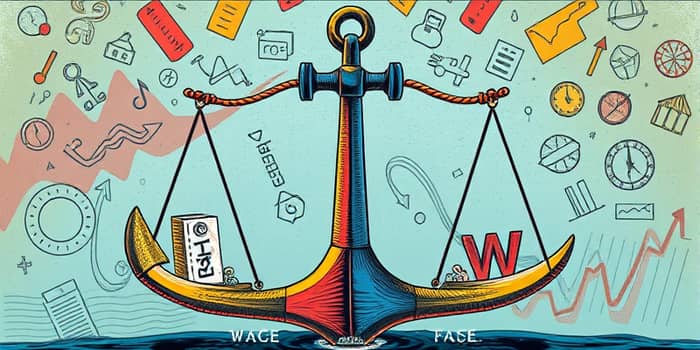
Inflation expectations anchor the trajectory of consumer prices by shaping economic behavior today. When households and businesses adjust spending, hiring, and pricing in anticipation of future price changes, expectations become a powerful determinant of actual inflation. This article explores the role of anchored expectations in guiding forecasts, highlights recent data trends, and offers practical insights for both policymakers and consumers seeking clarity in a volatile economic environment.
At its core, inflation expectations refer to the anticipated rate at which overall prices will rise over a given period. Central banks and economists measure these expectations through surveys and market indicators, interpreting shifts as signals about future inflation dynamics. Anchored inflation expectations influence price decisions, ensuring that long-term forecasts remain stable even amid temporary shocks. When consumers believe inflation will hover near a central bank’s target, their wage demands align accordingly, and firms are less inclined to preemptively raise prices.
Such stability is vital for sustaining purchasing power and preserving economic confidence. A well-anchored expectation framework acts like a compass, guiding monetary policy and helping to maintain price stability and maximum employment, the twin aims of many central banks around the world.
Expectations serve as a feedback loop between public sentiment and actual outcomes. When households foresee rising prices, they may accelerate purchases, prompting businesses to ramp up production and potentially bid up input costs. Conversely, if forecasts remain tame, consumer spending patterns become less volatile, and firms can maintain more measured pricing strategies. This dynamic underpins a self-fulfilling inflationary cycle or, conversely, supports steady price growth.
The Federal Reserve closely monitors metrics like the New York Fed’s consumer survey, in which the median one-year-ahead inflation expectation fell to 3.2% in May 2025, down from 3.6% in April. Aligning public expectations with its 2% long-term target often involves transparent communication and, when necessary, decisive policy actions to signal commitment to price stability.
Recent months have shown signs of easing consumer anxiety about price surges. Improved labor market conditions—characterized by low unemployment and robust job creation—coupled with softening commodity prices have contributed to a downward revision in short-term forecasts. While one-year-ahead expectations remain above target, longer horizons have edged closer to desired levels, with three-year forecasts at 3.0% and five-year outlooks at 2.6%.
Yet history reminds us that consumer forecasts often diverge from actual inflation. Between 1984 and 2021, the correlation between realized year-over-year CPI inflation and consumer forecasts was approximately 0.08, suggesting little alignment. This gap underscores the importance of weighting all price categories according to official baskets rather than focusing on volatile segments.
Moreover, central banks often cross-check survey-based expectations with market indicators like break-even inflation rates derived from Treasury Inflation-Protected Securities (TIPS). When TIPS-derived expectations align with survey forecasts, policymakers gain confidence in the broad alignment of market signals. Discrepancies, however, can prompt further investigation and communication efforts to clarify the outlook.
Different groups produce varied inflation forecasts, influenced by methodological approaches and data usage. International evidence also shows that firm managers in other developed economies may forecast inflation slightly above official targets at short horizons, yet converge inward over longer periods. These patterns highlight the global nature of expectation management in an interconnected world.
Professional forecasters typically leverage sophisticated econometric models, while businesses draw on proprietary surveys and market intelligence. Consumers, however, may base projections on recent experiences, especially spikes in grocery or gasoline costs.
Such disparities highlight the need for transparent communication of forecast methodologies and the value of holistic price indices. By understanding these differences, policymakers and stakeholders can better interpret survey results and market signals.
Several factors contribute to the persistent wedge between consumer and expert inflation expectations. Key drivers include:
Addressing these biases requires improved financial literacy and education, ensuring that individuals understand how core inflation metrics exclude volatile segments to provide clearer signals about underlying price trends.
An inflation anchor weakens when long-term expectations drift away from targets. Historical episodes reveal that repeated overshoots or communication missteps by central banks can erode credibility, leading to a cycle of higher inflation that becomes difficult to reverse. Reanchoring may demand repeated inflation overshoots and credibility loss to be countered by strong policy responses, such as rapid rate hikes or explicit forward guidance.
Effective reanchoring combines clear messaging with demonstrable policy commitments. Central banks might publish explicit inflation ranges, enhance transparency in decision-making, or adopt numerical targets for asset purchases. Through such measures, they can rebuild trust and guide both market-based and survey-based expectations back toward desired levels.
For the average consumer, staying informed about multiple inflation indicators can provide context beyond anecdotal price experiences. Utilizing published surveys from reputable institutions helps form a more balanced view of future price trends. Policymakers, meanwhile, must prioritize credibility and clarity, ensuring that their actions consistently reflect their stated objectives.
Educators and financial advisors can support individuals by simplifying explanations of inflation data, using real-world examples to illustrate the difference between headline and core measures, and guiding them toward trusted information sources.
By monitoring expectation metrics and understanding their transmission into actual inflation, stakeholders can make more informed decisions—whether negotiating wages, setting long-term budgets, or adjusting investment portfolios. Strong anchoring of expectations remains the foundation for sustained economic stability and growth.
Inflation expectations serve as a guiding force in the economy, shaping both individual behaviors and broad policy outcomes. When well anchored, they foster confidence and predictability. Maintaining that anchor requires constant vigilance, transparent communication, and, when necessary, decisive interventions. Through collaborative efforts between central banks, businesses, and households, it is possible to preserve the integrity of inflation forecasts and support enduring economic stability.
Ultimately, every decision—from household budgets to corporate investment planning—benefits from a clear understanding of inflation expectations. By acting on reliable forecasts and remaining aware of signals from central banks and markets, we can collectively reinforce the anchor that underpins price stability for decades to come.
References













